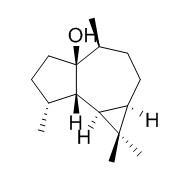Palustrol
Palustrol exhibits acaricidal, insecticidal, ‘pesticidal’ and/or arthropod repellent properties, may be useful sources of chemicals for the control of arthropods of medical, veterinary or agricultural importance.
Inquire / Order:
manager@chemfaces.com
Technical Inquiries:
service@chemfaces.com
Tel:
+86-27-84237783
Fax:
+86-27-84254680
Address:
1 Building, No. 83, CheCheng Rd., Wuhan Economic and Technological Development Zone, Wuhan, Hubei 430056, PRC
Providing storage is as stated on the product vial and the vial is kept tightly sealed, the product can be stored for up to
24 months(2-8C).
Wherever possible, you should prepare and use solutions on the same day. However, if you need to make up stock solutions in advance, we recommend that you store the solution as aliquots in tightly sealed vials at -20C. Generally, these will be useable for up to two weeks. Before use, and prior to opening the vial we recommend that you allow your product to equilibrate to room temperature for at least 1 hour.
Need more advice on solubility, usage and handling? Please email to: service@chemfaces.com
The packaging of the product may have turned upside down during transportation, resulting in the natural compounds adhering to the neck or cap of the vial. take the vial out of its packaging and gently shake to let the compounds fall to the bottom of the vial. for liquid products, centrifuge at 200-500 RPM to gather the liquid at the bottom of the vial. try to avoid loss or contamination during handling.
J Chromatogr B Analyt Technol Biomed Life Sci.2022, 1203:123307.
Adaptive Medicine 2020, 12(1): 4-10
Phytochemistry.2024, 222:114102.
Korean J Acupunct2020, 37:104-121
SBRAS2016, 12
Babol University of Medical Sciences2024, rs-4289336
Iranian J. Pharm. Res.2021, 20(4):59-70
Food Res Int.2020, 133:109130.
Int J Mol Sci.2024, 25(12):6456.
J.Food Pharm.Sci.2024, 12(2), 116-124.
Related and Featured Products
Med Vet Entomol. 2005 Dec;19(4):345-52.
Evaluation of extracts and oils of tick-repellent plants from Sweden.[Pubmed:
16336298 ]
METHODS AND RESULTS:
Leaves of Myrica gale Linnaeus (Myricaceae), Rhododendron tomentosum (Stokes) H. Harmaja (formerly Ledum palustre Linnaeus: Ericaceae) and Artemisia absinthium Linnaeus (Asteraceae) were extracted with organic solvents of different polarities and the essential oils of leaves were obtained by steam distillation. The extracts or oils were tested in the laboratory for repellency against host-seeking nymphs of Ixodes ricinus Linnaeus (Acari: Ixodidae). Rhododendron tomentosum oil, 10%, diluted in acetone, exhibited 95% repellency; R. tomentosum and A. absinthium extracts in ethyl acetate, > 70% repellency; A. absinthium extract in hexane, approximately 62% repellency; and M. gale oil, 10%, approximately 50% repellency on I. ricinus nymphs. Compounds in the leaf extracts or in the oils were collected by solid phase microextraction (SPME) and identified by gas chromatography-mass spectrometry (GC-MS) and/or MS. Characteristic volatiles detected from oil or extract of M. gale were the monoterpenes 1,8-cineole, alpha-terpineol, 4-terpineol and thujenol; and of R. tomentosum myrcene and Palustrol. Characteristic volatiles from leaf extracts of A. absinthium were sabinene, oxygenated monoterpenes, e.g. thujenol and linalool, and geranyl acetate.
CONCLUSIONS:
Each plant species synthesized numerous volatiles known to exhibit acaricidal, insecticidal, 'pesticidal' and/or arthropod repellent properties. These plants may be useful sources of chemicals for the control of arthropods of medical, veterinary or agricultural importance.
New Phytol. 2010 May;186(3):722-32.
Birch (Betula spp.) leaves adsorb and re-release volatiles specific to neighbouring plants--a mechanism for associational herbivore resistance?[Pubmed:
20298484]
Plant-emitted semi-volatile compounds have low vaporization rates at 20-25 degrees C and may therefore persist on surfaces such as plant foliage.
METHODS AND RESULTS:
The passive adsorption of arthropod-repellent semi-volatiles to neighbouring foliage could convey associational resistance, whereby a plant's neighbours reduce damage caused by herbivores.
We found that birch (Betula spp.) leaves adsorb and re-release the specific arthropod-repelling C(15) semi-volatiles ledene, ledol and Palustrol produced by Rhododendron tomentosum when grown in mixed association in a field setup. In a natural habitat, a higher concentration of ledene was released from birches neighbouring R. tomentosum than from birches situated > 5 m from R. tomentosum. Emission of alpha-humulene, a sesquiterpene synthesized by both Betula pendula and R. tomentosum, was also increased in R. tomentosum-neighbouring B. pendula. In assessments for associational resistance, we found that the polyphagous green leaf weevils (Polydrusus flavipes) and autumnal moth (Epirrita autumnata) larvae both preferred B. pendula to R. tomentosum. P. flavipes also preferred birch leaves not exposed to R. tomentosum to leaves from mixed associations. In the field, a reduction in Euceraphis betulae aphid density occurred in mixed associations.
CONCLUSIONS:
Our results suggest that plant/tree species may be protected by semi-volatile compounds emitted by a more herbivore-resistant heterospecific neighbour.



